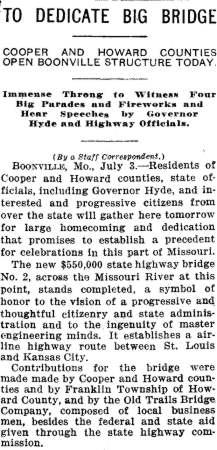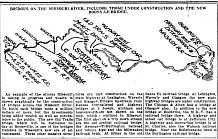The Boonville bridge over the Missouri River was opened on Independence Day 1924. It carried State Highway No. 2, the major highway between Kansas City and St. Louis. Highway 2 subsequently became US 40, which still goes through downtown Boonville.
The opening of the bridge was apparently a big event around the state, as indicated by this article from the July 4, 1924 issue of the Kansas City Times. I happen to have this newspaper page because, on the reverse side, the Times had printed a reproduction of the Declaration of Independence (as it did every July 4th for many years).
Here are some fair use excerpts from the article:


The Times also published this map of Missouri River bridges to accompany the article. The map refers to the Boonville highway bridge as the "Old Trails" bridge. You can also view a larger image of the map as well as the caption below it by clicking on the links in this caption.
(By a Staff Correspondent.)
Boonville, Mo., July 3.-Residents of Cooper and Howard counties, state officials, including Governor Hyde, and interested and progressive citizens from over the state will gather here tomorrow for large homecoming and dedication that promises to establish a precedent for celebrations in this part of Missouri.
The new $550,000 state highway bridge No. 2, across the Missouri River at this point, stands completed, a symbol of honor to the vision of a progressive and thoughtful citizenry and state administration and to the ingenuity of master engineering minds. It establishes a airline highway route between St. Louis and Kansas City.
Contributions for the bridge were made made by Cooper and Howard counties and by Franklin Township of Howard County, and by the Old Trails Bridge Company, composed of local business men, besides the federal and state aid given through the state highway commission.
BRIDGE 2,100 FEET LONG.The bridge was designed and supervised by Harrington, Howard & Ash of Kansas City. It rests on seven concrete piers. Its total length is 2,100 feet, with an approach on the Cooper County side of 584 feet, and a 500-foot earth and macadam approach on the Howard County side. The structure is a continuation of Boonville's main street. It stretches out northward overlooking Howard County, whose lands lie lower than the south banks composed of bluffs.
The contract was let in February, 1922, and the first girder was swung August 2, 1923.
The Missouri-Kansas-Texas railway bridge stands about a half mile west up the river. It was built in the early '70s [that would be the 1870's--MR], with vehicular accommodations. Boonville and the two counties were so completely indifferent then to build roads and approaches, the traffic flooring was torn away and never replaced. A later attempt for a traffic bridge failed. Soundings were made at the site of this new bridges at that time. These were used for the structure now completed.
Other bridges in the system to connect the network of state highways now are under construction at Glasgow, Waverly and Lexington. The four, including this one at Boonville, will cost $2,894,619.
The article described Boonville as "aflutter with flags and bunting", with an estimated crowd of up to 15,000 people expected to witness the July 4th ceremony:
The day's program will start with a sunrise salute fired by forty-eight 78 mm. guns on the bluffs overlooking the Missouri River. Special trains from Clinton, Slater and Sedalia will arrive early.
There will be four big parades in the day in which units of the 128th field artillery, six hundred boys from the state reformatory here, and various out-of-town hands will participate.
At 12 o'clock noon, Mayor Fleet of Franklin, across the river in Howard County, and a delegation of citizens will be met at the center of the bridge by Mayor W. G. Pendleton, of Boonville, who will have an escort. The mayors will clasp hands, thus symbolizing the union of the two counties. A United States dirgible, sent here by the war department, will act as an overhead witness to this ceremony.
The article went on to report that Missouri Governor Arthur Mastick Hyde was scheduled to speak shortly after the symbolic clasping of hands, along with Theodore Gary, state highway commission chairman, and a representative of the Federal Bureau of Roads.
The bridge was replaced 72 years later, in 1998. For a brief time, sections of the old bridge stood side by side with sections of the new bridge.
Denver, Colorado
E-mail: Please see the Contact Information page.